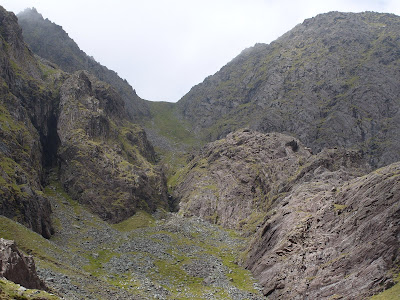If you have ever climbed or descended Corrán Tuathail via the "3 levels" or Coum's, you may have spotted the family of Feral Goats....
 What does ‘feral’ mean?
What does ‘feral’ mean? The word feral means that these goats are descended from domesticated or farm animals, rather than coming from a native wild population. The nearest native wild goats and sheep occur in the Alps and south-eastern Europe, so any ‘wild’ goats here were originally brought over by humans.
When were goats first brought to Ireland?
It is thought that the first goats were brought over about 4000 years ago. Goats were very useful and hardy animals, kept for their milk, meat, hair and hides. Over time, some escaped and others were released, eventually forming wild populations. Even now, you will occasionally see a formerly domestic, soon-to-be-wild goat joining a feral herd.
Where do feral goats live?
Most feral goat herds in Ireland are in remote, mountainous areas. The most famous herds are in Killarney, the Burren and Glendalough, but there are also smaller populations in other hilly areas such as the Mournes, Connemara and Waterford.
What do feral goats look like?
The male is known as a billy, the female as a nanny, and the young as a kid. Both billies and nannies have a beard, and long horns sweeping back from the head, with males growing longer horns. The coat is long and shaggy and may be black, brown, white or grey, often mixed in various patterns.
Do feral goats live in groups?
Like most ruminants (grazing mammals with cloven hooves and a chambered stomach) feral goats are herd animals. Herds are led by a dominant female with up to a dozen other females. Males usually live in separate herds, but sometimes herds of up to 100 can be seen, if goats are driven down into valleys by bad weather.
When are kids born?
The breeding season, known as the rut, occurs between August and December. The billies display their fitness by shaking their heads, lowering their horns and occasionally head-butting other males. Gestation is about 5 months, so the kids are born in spring.
What do feral goats eat?
Goats have a reputation for eating everything and anything, but it’s unlikely that they’ll actually eat the clothes off your washing line! They do, however, eat any vegetation they find, such as grasses, sedges, heather and bilberry in the mountains, young trees and shrubs in woodlands, and even seaweeds on the coast. Like all ruminants, goats have a stomach divided into four compartments, for digesting tough plant material.
Do feral goats have any predators?
In modern-day Ireland, nothing hunts feral goats for food; not even humans. Up until 200 years ago, the wolf may have been their main predator. However, if numbers of goats increase to the point that they damage their surrounding habitat, e.g. eating young tree saplings, some goats may have to be culled by National Park staff, foresters and other land managers.
How long do feral goats live?
In the wild, despite the ancient appearance of some individuals, the average natural lifespan is about 8 years.
Do feral goats make noises?
Like their domestic cousins, feral goats make a bleating sound probably best transcribed as ‘meh-eh-eh-eh-eh’. In spring, the high-pitched bleating of the kids in the mountains can sound worryingly similar to somebody in distress and calling for help!
How do feral goats climb on cliffs?
For a large animal, goats are very agile on cliffs, jumping from ledge to ledge to reach plants and shrubs growing on almost sheer cliffs. As well as having naturally good balance, the hooves of the feet have a hard outer rim and a spongy surface underneath. These act like suckers, helping the goat to gain a firmer hold and better leverage on the rock.
Are feral goats protected?
For a non-native animal, goats have quite a high profile in Irish culture. Their many uses over the centuries (eg milk for cheese, skin for bodhrans). their association with wild mountainous areas and their stubborn independent spirit means that many people regard them with fondness. Although goats are sometimes culled to protect sensitive habitats, it is not permitted to hunt them without a permit.





